
Four “burning” questions on NIV @DrLeoHeunks - does NIV worsen lung injury ? #LIVES2022 #ventilation #niv @ESICM
This is an important question as “harm” from prolong NIV without being able to protect lungs. Assess Tidal volume during NIV. “High TV independent risk factor for NIV failure “. NOT causation but important observation.
Of course Leo comes back to Tonelli article using oesophageal catheter in de novo Resp failure NIV. 😍😍😍this study. Normal 4-5 cmH2o. These patients have very high effort ~20. What’s remarkable is the change in first 2 hours ! 

What’s the additional evidence? Esnault. Intubated. Covid patients. On assist mode. Monitoring p0.1 showed that higher effort is associated with lung injury. atsjournals.org/doi/10.1164/rc… 

How do we lower effort? It’s tricky as multiple pathways afferents. Higher PEEP may improve effort. Again subgroup but helmet ventilation tend to have lower rate if intubation.
Take home message 1. Physiological and pilot data support concept of P-SILI. 2. High effort is associated with harm. 3. If NIV is to be trialled then do it in a monitoring environment where rapid response and intubation can be provided. #LIVES2022 #ventilation
Q1. Reduce drive /effort by high PEEp? Why? Perhaps if diaphragm is flatten then patient is not able to make an strong effort despite drive. Q2. Oesophageal ballon is the gold but there’s little use. There’s a correlation between that and nose flaring.
@threadreaderapp unroll
• • •
Missing some Tweet in this thread? You can try to
force a refresh









